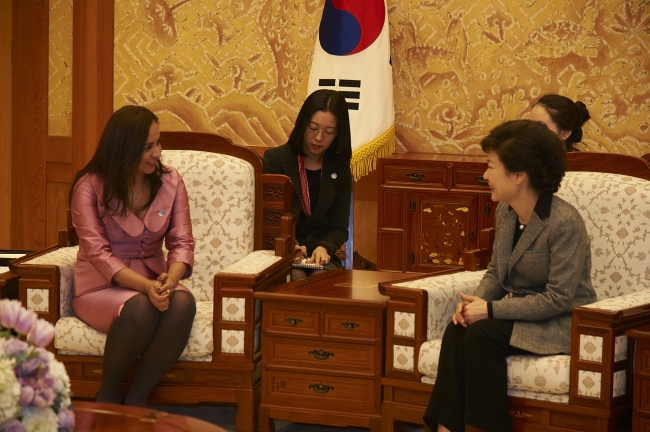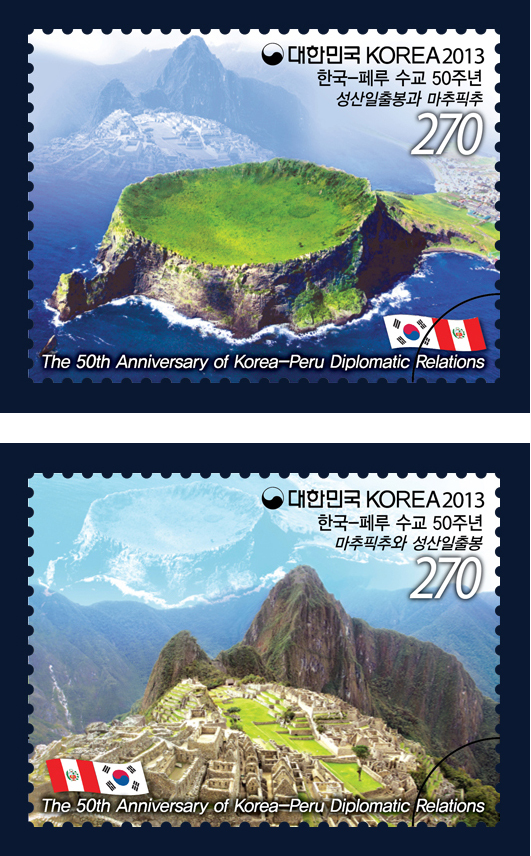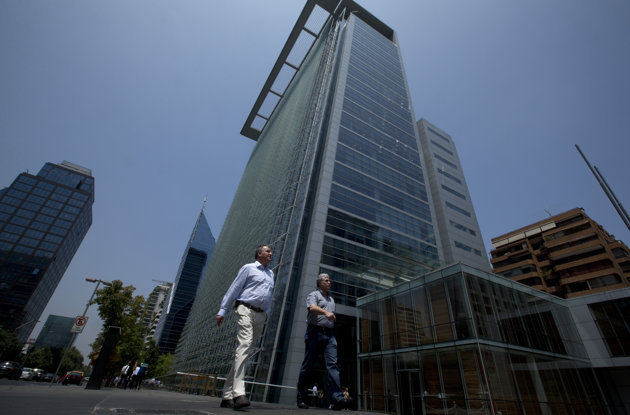Peru and the Republic of Korea established diplomatic relations on April 1, 1963, and has now completed 50 years of friendship and cooperation.
Some might ask what has created such a strong and lasting bond between the two countries which are so far apart. The reason is that during the past 50 years both countries have learned to know and understand each other, and also how to identify the areas in which to cooperate and move forward together.
Bilateral relations with Korea have a special meaning for Peru. Even though Korea is neither a neighboring country nor part of the integration processes being carried out in South America, its participation in economic forums such as Asia-Pacific Economic Cooperation and its determination to link with Peru enrich the bilateral agenda at a preferential political level.

Peruvian Vice President Marisol Espinoza (left) talks with President Park Geun-hye on Feb. 26. (Peruvian Embassy)

Stamps commemorating the 50th anniversary of Korea-Peru diplomatic relations
Fifty years later, the bilateral relations between Peru and Korea show steady growth and dynamism, which has been most evident in recent years. In this context, economic complementation also converges between the two: Korea imports mineral and hydrocarbon resources, and Peru provides these resources and imports appliances and vehicles from Korea at the same time. Another key factor in the bilateral relations, which accompanies the growth and development achieved by Korea, is the level of cooperation with Peru.
Relations with Korea should be built up in several ways. In the political field, there is a comprehensive strategic partnership, established on May 10, 2012, during the state visit to Korea by President Ollanta Humala. This partnership is the basis for further existing areas of cooperation and also creates new spaces for trade, investment, science and technology transfer, cooperation for development and social inclusion, security and defense, and environment and culture.
In the economic and trade fields, the free trade agreement signed on March 21, 2011, recognizes the complementarities of both economies, providing greater opportunities for development and expansion. From one side, major Korean exports to Peru are high-tech products, and in the Korean market, fresh, high-quality products from Peru are consumed.
Notably, the commercial exchanges reached $3.2 billion in 2011 and 2012. The trade balance was in favor of Peru in 2011 with a $198 million surplus, and to Korea in 2012 with $120 million. These figures are even higher than those of 2010, when trade reached $1.9 billion and Korea’s trade surplus was $146 million.
This is part of a long process in which the productive sectors and exporting countries should adapt to the new needs and new markets. It is important to point out that in 2011 and 2012, Peruvian exports to Korea, approximately $700 million, surpassed the figures recorded in 2010.
There is also potential for the presence of more Peruvian products in the Korean market, but the main obstacle is given by barriers in the certification processes, which, despite the FTA, have not yet been completely overcome. In 2011, Peru gained market access for its grapes and it is now working on opening the market for its mangoes, to be followed by citrus fruits: lemons, limes, grapefruits, oranges and tangerines.
In this respect, Peru will try to facilitate the entry of products that require certification via ongoing negotiations with the Korean government agencies.
Additionally, both countries will promote commercial visits and participation in fairs in Korea and Peru. Peru will also concentrate efforts in broadening the presence of Peruvian products that do not require certification, such as clothing, jewelry, chemicals, industrial dyes and others.
As of today, more than 40 Korean companies are investing in Peru, with a total input of $3.5 million, making the country one of the largest recipients of Korean investment in the region.
On the Peruvian side, there are some small and medium-sized Peruvian entrepreneurs operating in Korea, especially oriented to distribution of products and machinery.

Lima, the capital of Peru
It is also important to remember that from May 10, 2012, both countries gained another tool to facilitate investment: the agreement to eliminate double taxation and prevent evasion of income tax.
On April 10, the Embassy of Peru and Proinversion (the Peruvian agency responsible for promoting private investment) organized a presentation which was attended by 150 Korean executives, 30 of which held one-on-one meetings with the representatives of Proinversion. As a result of these meetings, there are real possibilities of huge investments in projects such as the Lima Metro System, ports, airports, electric and broadband transmission lines and irrigation projects.
In the field of tourism, last year saw an increase in the number of Korean tourists who visited Peru. While in 2010 were 7,000 visitors, by September 2012 the number for the year had reached 10,000.
In addition to the permanent promotion wholesale operators, it is important to help Korean Air achieve its travel plans for passengers to Peru, and thus become a very important partner in promoting Peru as a tourist destination for Koreans.
In the field of cooperation, the bilateral relations have acquired greater dynamism. Peru, despite being considered a middle-income country and therefore lower-volume beneficiary of cooperation, is the largest recipient in Latin America for financing development projects, with an amount exceeding $10 million a year.
In recent years, new areas of cooperation have been added to the bilateral agenda, such as science and technology, environment, construction, agriculture, oceanography, energy, air connectivity, nuclear energy, and defense and security, among others. They are all part of the future of the bilateral relations.
As a final note, it is vital to stress the full support of the Republic of Peru to the Republic of Korea, at this moment of high tension on the Korean Peninsula. This support was expressed by President Ollanta Humala to President Park Geun-hye by telephone last week.








